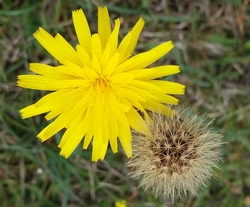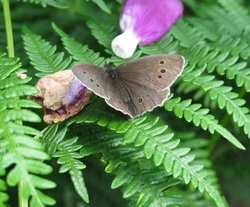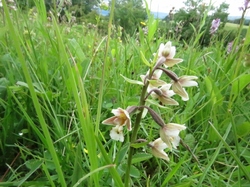 Haylage making north of Kendal Race Course 31 July 2016
Haylage making north of Kendal Race Course 31 July 2016
 Haylage making north of Kendal Race Course 31 July 2016 Haylage making north of Kendal Race Course 31 July 2016 Tomorrow, 1 August 2016, sees the Lake District National Park extended to include the whole of Scout Scar and Helsington Barrows. It’s something to celebrate. It’s an opportunity to raise awareness about endangered species and to do all we can to we protect them. I want to know what practical benefits being in the Lake District National Park will bring for wildlife. Scout Scar is a Site of Special Scientific Interest but how will visitors know that? On 1 August I’d like to know what you see and enjoy. What makes the day memorable for you?
0 Comments
 Fairies' bonnets, Trooping crumble cap 27 July Fairies' bonnets, Trooping crumble cap 27 July Eskdale on a fine summer’s day. The end of the line for Little Ratty and everyone disembarks at Dalegarth Station. Pub gardens are lively at lunchtime and a infant in a cradle waves his feet and stuffs them into his mouth. A young cocker spaniel is on its first outing. Sunlit cloud rides the fells. The campsite is quiet at mid-day and within the small plantation it is quieter still. Above the River Esk tall conifers reach for the light. Fallen trees, boulders and mossy rocks strewn over a thick layer of pine needles. A magic of shadows and sunlight.  Red-tailed bumblebee nectaring on ragwort 23 July Red-tailed bumblebee nectaring on ragwort 23 July Last summer I was in the Outer Hebrides, walking beside the Atlantic Ocean through the machair- a shell sand dense with white clover. In the afternoon the sun broke through the clouds, the ocean lit all shades of aquamarine and as the temperature rose the flowers of the machair released their nectar and a heady fragrance filled the air. Sensational. I long for white clover honey to taste the day once more. So, what’s your favourite honey: clover, heather, manuka? I doubt anyone would opt for ragwort honey but wild bees are eagerly nectaring on its flowers. Don’t they know it’s toxic?  Flower and seed head of hawkbit 23 July Flower and seed head of hawkbit 23 July -Summer races away and change comes so swiftly. There’s a yellow motif to the Scout Scar flora with lady’s bedstraw and hawkbit, hawkweed and cat’s-ear – a glory of flowers on the limestone escarpment. Seed-heads are beautiful too. Down below, at Bradleyfield Farm, the flock is making a din as lambs and ewes are parted from each other. The farmhouse is surrounded with a cacophony of sound. Blackthorn is thick with green sloes which should bode well for the damson crop in the Lyth Valley. On hot July mornings the swifts screech about the house, volleys of them. Soon they will be gone. With flowers the same, their time is brief.  Yellow Horned Poppy 13 July Yellow Horned Poppy 13 July A summer ferry takes passengers from Roa Island out to Piel island, then across Piel Harbour to see the grey seals basking on shoals. A day of wonderful cloudscapes, a day to bask in the sun- fortunate because we have an enforced lingering. Our field-trip was well organised but the ferry service was not. There should have been two ferries, two crew in each. A single crewman plied a single ferry. So waiting about and queuing was the order of the day. Luckily the sun shone and there were wildlife attractions.  Ringlet beside Swindale Beck, 14 July 2016 Ringlet beside Swindale Beck, 14 July 2016 She gathered seed-heads of cotton grass to make shirts for her seven brothers, seven shirts to free her swan- brothers from enchantment, silken shirts to break the spell. * Plumes of hare’s-tail cotton grass catch the light over Hare Shaw where the moors are rich in flowers of cross-leaved heath, bell heather and green-budding ling. To the west, the lost village of Mardale is a ghostly presence, resurrected from Haweswater in a summer of drought. The Old Corpse Road rises over Mardale Common where once the villagers grazed their flocks. The dead were borne over the moor to Swindale Head and on to Shap to be buried.  Marsh Helleborine at Waitby Greenriggs 5 July Marsh Helleborine at Waitby Greenriggs 5 July A week of exploration in different locations across Cumbria. There are seasonal highlights I hope to find afresh each year: flowers galore and birds too. And sensations: the fragrance of flowers in species-rich grassland at Waitby Greenriggs and Smardale and on Scout Scar. Rain is never far off during this week: rushing water resounds in a Lake District landscape and there are ribbons of cascades coming off the fells.  English Stone Crop, near Tarn Hows 30 July English Stone Crop, near Tarn Hows 30 July One winter’s day, I remember seeing a stand of bog myrtle- dark twigs rising above the ice surrounding Tarn Hows. Today, the shrubs are leafy green and fragrant, amongst fragrant water mint. Cotton grass and orchids too, and bog asphodel. On outcropping rock there’s a different flora: English stonecrop and bilberry whose bluish fruits begin to ripen. Marsh valerian- ‘ it smells of horses, ’ says a friend. We hear a loud barking and scan the trees until we find a deer in full cry. |
Archives
July 2024
Categories
All
|

 RSS Feed
RSS Feed